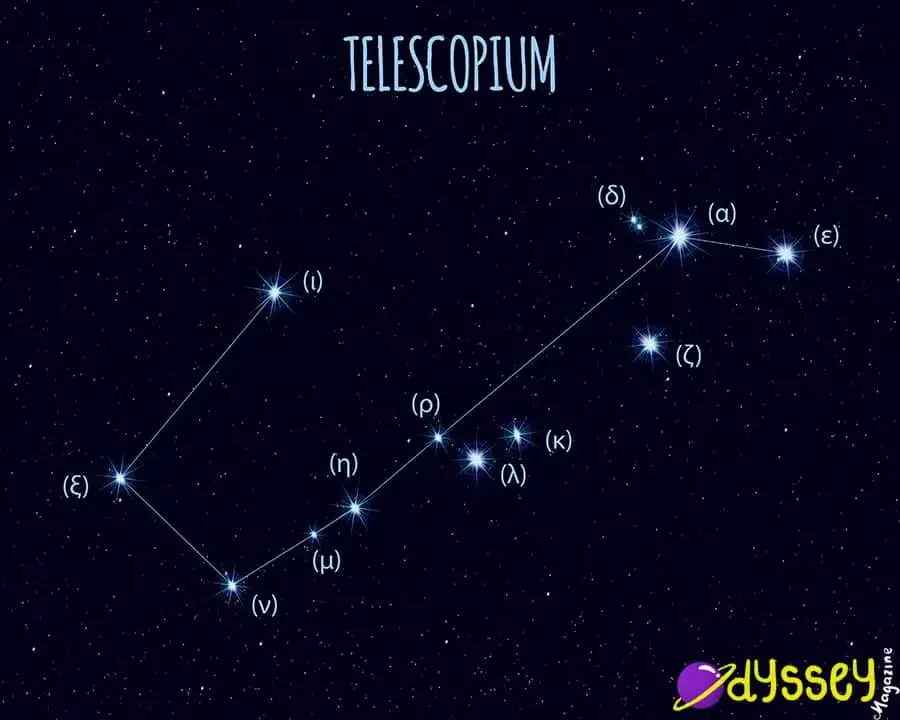Telescopium Constellation
The Telescopium constellation is one of the few constellations which was named to represent scientific tools and instruments – it’s pretty easy to see where it got it’s named from! Lets have a look at some of the most interesting things about the Telescopium minor constellation.
- Bordered By; Ara, Corona Australia, Indus, Microscopium, Pavo, Sagittarius
- Named after; The Telescope
- Declination; -50°
- Brightest Star; Alpha Telescopiii
- Best seen; Southern Hemisphere, January
- Size rank; 57th
- Constellation family; La Caille
- Pronunciation; TEL-LEH-SCO-PEA-UM
It isn’t hard to work out what the Telescopium constellation is named after; the telescope, of course! There are other constellations also named after scientific instruments, such as Microscopium and Sculptor.
The Telescopium was founded by French Astronomer Nicolas-Louis de Lacaille. He founded 14 of the constellations that we use today, and we refer to them as being from the Lacaille family. Interestingly enough, Lacaille was a mathematic professor and actually bound to spend his life in priesthood, but actually chose to become an astronomer instead. His work was vital in knowing the distances between planets, as well as identifying constellations. Much of his work was done in South Africa, whilst speaking to other astronomers in Europe and comparing notes.
The Telescopium black hole, known as QV Telescopii or HD 167128, is visible to the South West of Telescopium. It is the first black home identified in a constellation that is visible to the naked eye.
As we can see, there are many different stars of the Constellation Telescopium. Let’s identify some of them so we know which stars go where!

- Alpha Telescopii (a) – Alpha Telescopii is the brightest stars within the Telescopium constellation. It was actually part of Corona Australis until it Telescopium was identified in the 1700s. It is a variable star, so it’s brightness changes throughout time.
- Zeta Telescopii (ζ) – Known as the second brightest star, Zeta Telescopii is approximately 127 light years from the Sun. It is visible without a telescope, as it is a red clump star, meaning that it’s a cluster of red giant stars that were possibly once similar to the Sun.
- Epsilon Telescopii (ε) – Epsilon Telescopii is a singular solitary star with an orange coloring, and has a luminosity approximately 293 times brighter than the Sun.
- Lambda Telescopii (λ) – This is a single white star that is more than 268 million years old. It has 350x the luminosity of the Sun.
- Iota Telescopii (ι) – Iota Telescopii is visible to the naked eye. It is a giant star with 19x the radius of the Sun.
- Delta1 Telescopii (δ1) – Delta Telescopii is a blue/white star which is barely visible without a telescope. It is a subgiant star, which means that it’s not quite as bright as a giant star.
- Xi Telescopii (ξ) – It is a solitary star that is a massive 1100 light years away from the Sun. It is likely categorized as a giant star due to it’s brightness!
- Eta Telescopii (η) – Eta Telescopii is actually relatively near Earth, as it’s part of the Beta Pictoris moving group of stars. It is quite young in star years, with astronomers stating that it is 12 million years old.
- Delta2 Telescopii (δ2) – Delta2 Telescopii is a young star system that is 40 million years old. It is a binary star, which means that it’s made up of two stars.
- Rho Telescopii (ρ) – Rho Telescopii is another binary star system with approximately double the mass of the Sun.
- Kappa Telescopii (κ) – This is a solitary star with a yellow hue. It is one of the oldest stars in the constellation, with an estimated 1.25 billion year lifespan.
- Nu Telescopii (ν) – Nu Telescopii is visible to the naked eye, with an estimated age of 686 million years old.
All in all, Telescopium is another interesting constellation that many people will never have heard of. It has no association with a myth like most constellations, instead being identified by Nicolas-Louis de Lacaille and named after his most prized possession, his telescope.